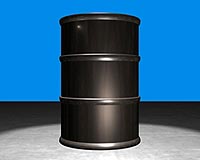 |
Robert, Louisiana (AFP) May 31, 2010 BP engineers on Monday scrambled a new high-risk operation to stem the devastating Gulf oil spill now described as the worst environmental disaster in US history. Hours after the British oil giant acknowledged the failure of its "top kill" attempt to plug the underwater well, company officials said it could take a week to carry out a bid to place a cap over the leak. "Right now we are going to a containment operation," BP Managing Director Bob Dudley told CNN television of the latest attempt to deal with the ruptured well nearly one mile (1,600 meters) under water. "Because this is being done at 5,000 feet with robots, we're going to take our time, do it extremely carefully. By the end of the week, we should have this in place," Dudley said. While the "top kill" would have sealed the well using heavy drilling fluid and cement, the new effort aims only to contain most of the leak, and might temporarily increase the amount of oil gushing into the Gulf of Mexico, officials said. The leak will only be sealed when BP finishes drilling two relief wells, but those are not expected to be ready until August. Hundreds of thousands of gallons of oil spew uncontrolled into the sea each day and at least 20 million gallons are now estimated to have escaped since the leased Deepwater Horizon oil rig exploded on April 20 and sank, killing 11 workers. Some 500 people braved rains in New Orleans' French Quarter Sunday to denounce BP and Barack Obama administration's response to the disaster. "Eco-murderers!" shouted Belinda Sopczak of New Orleans. Her protest sign featured a crude sketch of a black skull with BP's green and yellow logo over both eye sockets, and bearing the words "British Polluters." Obama's top environmental advisor, Carol Browner, said that it was possible that "we will have oil leaking from this well until August when the relief wells will be finished." The new bid involves using robots to sever a damaged pipe carrying oil from the wellhead and placing a containment device called a Lower Marine Riser Package (LMRP) over the leak. Oil would then be siphoned up to a container ship at the surface. But it is uncertain how much oil would be contained, Browner said on CBS's "Face the Nation progamme. "When you cut the riser, the kink may be holding some of the oil in and so we could see an increase, experts are saying, of as much as 20 percent," she said, adding the increase could last four to seven days as the cap is prepared. "Once the cap is on, the question is how snug is that fit? If it's a snug fit then there could be very, very little oil. If they're not able to get a snug fit then there could be more." Larry Crowder, a professor of marine biology at Duke University, said if the spill continues for a couple more months, then oil almost certainly would get into the Loop Current that flows clockwise around the Gulf. It then would be a week to 10 days before it got to the Florida Keys, and a couple of weeks more before the Gulf Stream carried it to North Carolina. "If you have enough oil, it can go a big distance," Crowder warned. "There's almost no place that's off-limits." Since the spill began, an estimated 12,000 to 19,000 barrels of crude have leaked into the Gulf each day. The disaster has already closed stretches of coastal fishing waters, endangering the seafood industry and tourism, and threatening a catastrophe for Louisiana marshes, home to many rare species. And scientists warned that the damage to the shorelines could be only the tip of the iceberg. The damage to the sea floor could be extensive, they said, and oil could also devastate marine life between the Gulf floor and its surface. Government data released Thursday suggested between 18.6 million gallons and 29.5 million gallons of oil have poured into the Gulf -- far more than the roughly 11 million gallons of crude spilled in the 1989 Exxon Valdez disaster. The spill has been a public relations nightmare for BP, which faced new allegations of negligence Sunday after The New York Times said internal company files showed the firm had serious concerns about the Deepwater rig weeks before the accident. Congressman Ed Markey, who forced BP to make available a live video feed of the oil leak, said Sunday he had "no confidence whatsoever in BP." "BP has been making it up as they go along the whole way," he said on "Face the Nation."
Share This Article With Planet Earth
Related Links Powering The World in the 21st Century at Energy-Daily.com
 US House votes quadrupling of per-barrel oil tax
US House votes quadrupling of per-barrel oil taxWashington (AFP) May 28, 2010 The US House of Representatives on Friday voted to more than quadruple a per-barrel oil tax that fills a special trust fund to pay for damages from major spills like the Gulf of Mexico disaster. The measure called for raising the eight-cent-per-barrel tax to 34 cents, raising nearly 12 billion dollars over 10 years for the Oil Spill Liability Trust Fund, which currently holds about 1.5 billi ... read more |
|
| The content herein, unless otherwise known to be public domain, are Copyright 1995-2010 - SpaceDaily. AFP and UPI Wire Stories are copyright Agence France-Presse and United Press International. ESA Portal Reports are copyright European Space Agency. All NASA sourced material is public domain. Additional copyrights may apply in whole or part to other bona fide parties. Advertising does not imply endorsement,agreement or approval of any opinions, statements or information provided by SpaceDaily on any Web page published or hosted by SpaceDaily. Privacy Statement |